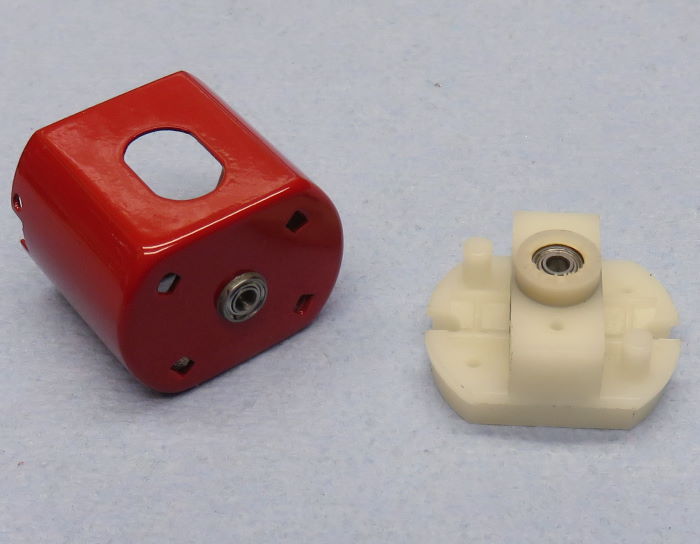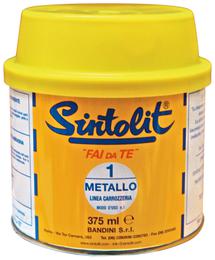...is something I've always hated. Epoxy can work...but the little plugs can fall right out and show up through the paint, even if they do stay put. Solder is far better, but getting the solder to "puddle" in the hole is devilishly difficult. Pretty much the best (*if you can call it that) success I've had is to tin the area with acid flux, clean all that up and neutralize the acid residue, then hit the area again with "NOKORODE" and silver solder. Even all that only works maybe half the time, with the solder wanting to go anywhere BUT in the hole. ![]()
Why bother? Because some (most) vintage cans are getting really scarce, so the ones I used to put aside in favor of cleaner examples are today's "head of the line". If you've done this when restoring old cans, what's your best method?

Filling old can screw holes with solder
#1

Posted 19 September 2019 - 07:05 AM
#2

Posted 19 September 2019 - 07:56 AM
I do the silver solder & acid flux method too. i've used 4% silver solder,rather than the high temp silver solder like I use on pinions. I once fixed a Dremel disc-made slit by first filling it with a length of .025 or .032 piano wire, then silver soldering. This wouldn't work for plugging holes. Also, I haven't been looking for "body shop" quality metal work because any can I've painted got wrinkle paint.
- havlicek likes this
I intend to live forever! So far, so good.
#4

Posted 19 September 2019 - 08:35 AM
John, 60/40 fills holes and jumps gaps much better than silver solder. Try it.
Also, I don't understand why you say you apply acid, then remove it. It has to stay on while soldering. Then clean up afterwards.
- havlicek likes this
Paul Wolcott
#5

Posted 19 September 2019 - 08:50 AM
I use a small square of .005 inch thick shim brass on the inside. That gives the solder a "bridge" to lay on. If
you are filling holes for the end bell screws or pins, you can use the shim method to fill the hole, then grind
some of it away until the EB fits in.
- havlicek likes this
#6

Posted 19 September 2019 - 10:42 AM
You can thread the hole and insert a corresponding threaded steel plug.
You can insert a non threaded plug in a plain hole.
bring the can to 50 degrees below solder lliquidus on a hot plate and apply additional heat to the plug itself.
Solder and then file and or grind, sand the area to match the can inner and outer surface.
Try something else.
Have an extra stout Guinness...
- havlicek likes this
Yes, to be sure, this is it...
#7

Posted 19 September 2019 - 12:31 PM
Hi John,
When I was learning how to do autobody repair when I was a teenager, I met a blacksmith (yes - he was very old) who shared with me this method of soldering small holes.
I had used this method during the 40+ years of automotive restoration, though the largest hole I ever soldered up was approximately 3/16".
ACID CORE SOLDER was the solder he told me to use - no external flux is required because this solder has an acid flux in its core which is an aggressive type designed to solder steel.
Acid core solder is used to attach pieces of sheet metal together.
The "acid core" is a type of flux aka chemical agent, that helps create a very strong bond between the pieces of metal being joined.
A thorough cleanup is required, just as if you applied a paste flux to the substrate, to prevent corrosion.
I've tried other types of solder to see if they would work just as well - be they did not!
I found a video of someone employing a similar method - of heating up the hole and then applying the solder.
I finished up the soldered holes with #180 grit on a DA sander, but in your case, you could file it down almost flush, and final sand with #400 girt sandpaper.
As for paint, I would apply a light coat of "self-etching" primer, let it flash, then apply the top coat of your choice.
I started learning to paint cars and so many other things back in 1967 and still painting today - it's so much fun! LOL
Here is the video - skipping to the 6:20 point of the video is where the technique starts.
https://www.youtube....h?v=368Xy18-PCM
Hope this was helpful.
Thank you.
Ernie
- havlicek and Geary Carrier like this
#8

Posted 19 September 2019 - 12:48 PM
I did not remember to mention that the surface area to be solder filled, should be "absolutely" free of any contaminants!
I typically clean the area with lacquer thinner wetting the clean shop paper towel, one pass of one side of the paper shop towel, then fold and wipe the residue with the other clean side.
I follow up with 50/50 mix of 70-90 percent Isopropyl Alcohol to water; wet the clean paper shop towel, wipe the surface, fold the shop towel in half and final wipe with the clean side.
This really aids adhesion whether you're soldering or prepping for paint.
Thank you.
Ernie
- havlicek and Geary Carrier like this
#9

Posted 19 September 2019 - 01:10 PM
Ernie,
Attention to detail... ![]()
Yes, to be sure, this is it...
#10

Posted 19 September 2019 - 01:15 PM
Just wanting to share, in the hopes that perhaps what little I have to offer, can be useful.
Thanks so much Geary!
Ernie
- havlicek likes this
#11

Posted 19 September 2019 - 01:23 PM
I apologize for not having mentioned this very important tip, because It is something out of habit that I do whenever I have to solder fill holes.
That is to put a taper on the hole/s to be filled, using a a slightly larger drill bit than the hole or a small countersink bit.
Doing this allows the solder to have a "seat" to prevent the solder from readily falling through the hole.
I'll go now - sorry!
Ernie
#12

Posted 19 September 2019 - 03:51 PM
Hi Ernie...thanks for all the useful info. I pretty much do all you said, but mostly have not used a filler or a backer...whether rod or screws, and may have to start doing that. It would be extra work, but probably less frustrating than my current hit-or-miss methods. ![]()
John, 60/40 fills holes and jumps gaps much better than silver solder. Try it.
Also, I don't understand why you say you apply acid, then remove it. It has to stay on while soldering. Then clean up afterwards.
![]() Um...yes Pablo. What i said is:
Um...yes Pablo. What i said is:
tin the area with acid flux, clean all that up and neutralize the acid residue,
The "tin" part is about getting a thin coat of solder on there using acid, THEN clean up and neutralize. ![]()
Thanks also for the other good suggestions. Like I said, I have to do more of this now than ever before, so I may as well figure out a better method while I'm still able to like...well...do this stuff at all!
#13

Posted 19 September 2019 - 04:43 PM
You're such the pioneer John!
Looking forward to seeing what you come up with!
Why not try using the welding device that you use to fuse the wire onto the armatures, to weld up the holes?!
Please share some pix of your solution John.
Thank you.
Ernie
#14

Posted 19 September 2019 - 07:44 PM
I'm a little skeptical that it would hold very well with your typical self tapping screw from that era.
In my opinion unless it's a replica of a specific historical car, you should go ahead and tin a sliver at the top of the corner of the can, and solder to the bracker, so you don't have to crank on those screws very hard.
And of course, with an anglewinder, have some sort of back brace to triangulate things.
Mike Swiss
Inventor of the Low CG guide flag 4/20/18
IRRA® Components Committee Chairman
Five-time USRA National Champion (two G7, one G27, two G7 Senior)
Two-time G7 World Champion (1988, 1990), eight G7 main appearances
Eight-time G7 King track single lap world record holder
17B West Ogden Ave., Westmont, IL 60559, (708) 203-8003, mikeswiss86@hotmail.com (also my PayPal address)
Note: Send all USPS packages and mail to: 692 Citadel Drive, Westmont, Illinois 60559
#15

Posted 20 September 2019 - 04:49 AM
People that have used solder, how well does it hold?
I'm a little skeptical that it would hold very well with your typical self tapping screw from that era.
I can't speak for anyone else here, but my original question was about filling holes for paint/finishing Mike...and then drilling holes for attaching the end bell in a different location. I wouldn't count on solder for holding a tapping screw at all. Brazing metal would probably work OK though and I have thought about doing that for the end mounting holes of Muras that have been stripped or opened up too far.
#16

Posted 20 September 2019 - 06:25 AM
After filling several old can screw holes, I gave this one "the treatment", drilled some new holes for mounting the end bell, removed the stock bearing and aluminum carrier, made and installed adapters for bearings on both ends and painted the can red. It may not look like it, but there's a fair amount of work just to get this far.

- slotbaker, Pete L., Fergy and 3 others like this
#17

Posted 20 September 2019 - 09:51 AM
In the case where I am repairing a stripped hole in a can, I grind down a nut very thin and solder it to the inside of the can. you
can use a screw to hold the nut in place, but coat it with graphite grease first. The solder won't wick into the greased area.
Not the best way, but if I am determined to used that motor for historical accuracy, it works OK. Certainly much stronger than
a nylon end bell that has it's screw holes worn out by continuous threading in and out by the mounting screws.
- Geary Carrier likes this
#18

Posted 20 September 2019 - 11:00 AM
I think it was Rick Thigpen who also used the soldered nuts. IIRC, he used aluminium 2-56 screws to hold the nuts in place while soldering.
- MSwiss, Fergy and Phil Smith like this
I intend to live forever! So far, so good.
#19

Posted 20 September 2019 - 11:29 AM
John,
With the technology you have developed for welding wires on the commutators I'm surprised your not able to fill the holes by welding.
#20

Posted 20 September 2019 - 01:10 PM
I was not the first to put nuts inside cans to reinforce them. Guys I knew were doing it in the 60's
- Jesse Gonzales likes this
#21

Posted 20 September 2019 - 01:28 PM
..........put nuts inside cans........... Guys I knew were doing it in the 60's
Probably predated the 60's, and slot racing. LOL
Mike Swiss
Inventor of the Low CG guide flag 4/20/18
IRRA® Components Committee Chairman
Five-time USRA National Champion (two G7, one G27, two G7 Senior)
Two-time G7 World Champion (1988, 1990), eight G7 main appearances
Eight-time G7 King track single lap world record holder
17B West Ogden Ave., Westmont, IL 60559, (708) 203-8003, mikeswiss86@hotmail.com (also my PayPal address)
Note: Send all USPS packages and mail to: 692 Citadel Drive, Westmont, Illinois 60559
#22

Posted 21 September 2019 - 05:57 AM
John,
With the technology you have developed for welding wires on the commutators I'm surprised your not able to fill the holes by welding.
Hi Ernie,
Welding would probably make things far worse without some really special setup designed for the job. For com/magnet wire connections, what I do is actually brazing using fairly high electrical current to get things hot quick. ***I have used brazing metal/flux on occasion to join steel, as in can seams, but it's a much more messy and difficult thing to do than solder, and for that I have used a minitorch to get the brazing metal and can up to the MUCH higher temps required. Anyway, I can't take ANY credit for "developing the technology" involved. I DID have to do a bunch of web-searching, question-asking and metal-ruining to get it to work for me, but arm makers have been doing this for a long time before I tried it. As was the case with powder-coating, and even *just* winding arms, there simply is no open source for detailed information, even though these all are ...and have been commonly done. The only way to learn to do this stuff is "the hard way". ![]() Even so, I only know how to do these things "my way", and have no idea if I do it THE way others do. I don't even know if there IS "THE way".
Even so, I only know how to do these things "my way", and have no idea if I do it THE way others do. I don't even know if there IS "THE way".
- Geary Carrier likes this
#23

Posted 21 September 2019 - 07:24 AM
- havlicek likes this
#24

Posted 21 September 2019 - 09:09 AM
Hi John, I wonder if it could be doable to cut a small tiny piece of metal (like those you use for shimming magnets) and solder it outside the can over the hole. I guess it could be easily polished with rotary tool until it almost disappears.
Hi Maurizio,
It would be easier to put the metal on the inside as described above, since the metal would only have to be taken down enough to make fitting the end bell work...not so much as to almost disappear under paint. I'll probably start just filling the hole with rod or a screw, instead of trying to make solder alone fill the hole.
- Jaeger Team likes this
#25

Posted 21 September 2019 - 10:02 AM
I was really hoping you'd try my trick of a simple 60/40 with acid solder job - it truly does fill a hole much better than silver solder. ![]()
As the acid is bubbling with the iron on it, hand feed the solder to it until the hole is full.
- havlicek and Geary Carrier like this
Paul Wolcott



















